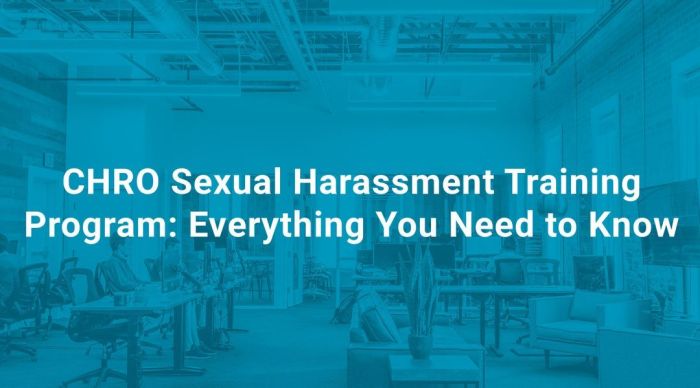CHRO sexual harassment prevention training plays a pivotal role in creating a respectful and inclusive workplace culture. It empowers employees to recognize, prevent, and report inappropriate behavior, fostering a safe and productive environment for all.
As per legal mandates and organizational best practices, CHRO sexual harassment prevention training is indispensable. It equips employees with the knowledge, skills, and resources necessary to navigate sensitive situations and maintain a positive work atmosphere.
Define and Explain Sexual Harassment
Sexual harassment is a form of discrimination that involves unwelcome sexual advances, requests for sexual favors, or other verbal or physical conduct of a sexual nature when:
- Submission to such conduct is made either explicitly or implicitly a term or condition of an individual’s employment.
- Submission to or rejection of such conduct by an individual is used as the basis for employment decisions affecting such individual.
- Such conduct has the purpose or effect of unreasonably interfering with an individual’s work performance or creating an intimidating, hostile, or offensive work environment.
Sexual harassment can take many forms, including:
- Quid pro quo harassment:This occurs when someone in a position of power or authority makes a job benefit contingent on sexual favors.
- Hostile work environment harassment:This occurs when the conduct creates an intimidating, hostile, or offensive work environment for the victim.
Examples of common behaviors that constitute sexual harassment include:
- Unwelcome sexual advances
- Requests for sexual favors
- Verbal or physical conduct of a sexual nature
- Displaying sexually explicit materials
- Making sexual jokes or comments
The Importance of Sexual Harassment Prevention Training
Employers are legally obligated to provide sexual harassment prevention training to their employees. This training is essential for creating a safe and respectful work environment for all employees.
Sexual harassment prevention training has many benefits for employees and organizations, including:
- Increased awareness of sexual harassment and its consequences
- Improved ability to recognize and respond to sexual harassment
- Reduced risk of sexual harassment occurring in the workplace
- Improved employee morale and productivity
- Enhanced reputation for the organization
Studies have shown that sexual harassment prevention training is effective in reducing the incidence of sexual harassment in the workplace. For example, a study by the Equal Employment Opportunity Commission (EEOC) found that organizations that provided sexual harassment prevention training had a 50% lower rate of sexual harassment complaints than organizations that did not provide training.
Elements of Effective Sexual Harassment Prevention Training: Chro Sexual Harassment Prevention Training

Effective sexual harassment prevention training programs include the following key components:
- Clear and concise definition of sexual harassment:The training should provide a clear and concise definition of sexual harassment, including examples of common behaviors that constitute sexual harassment.
- Explanation of the legal consequences of sexual harassment:The training should explain the legal consequences of sexual harassment for both the perpetrator and the organization.
- Training on how to recognize and respond to sexual harassment:The training should provide employees with the skills they need to recognize and respond to sexual harassment, including how to report it to their supervisor or HR department.
- Interactive activities:The training should include interactive activities, such as role-playing exercises and case studies, to help employees practice recognizing and responding to sexual harassment.
- Evaluation:The training should include an evaluation component to assess the effectiveness of the training and identify areas for improvement.
Training Methods and Techniques

There are a variety of training methods and techniques that can be used for sexual harassment prevention training. Some of the most common methods include:
- Interactive workshops:Interactive workshops are a great way to engage employees and provide them with the opportunity to practice recognizing and responding to sexual harassment.
- Online modules:Online modules are a convenient way to provide employees with training on their own time and at their own pace.
- Role-playing exercises:Role-playing exercises allow employees to practice recognizing and responding to sexual harassment in a safe and controlled environment.
The best training method or technique will vary depending on the size and culture of the organization. It is important to choose a training method that is engaging and informative and that meets the needs of the employees.
Evaluating the Effectiveness of Sexual Harassment Prevention Training

It is important to evaluate the effectiveness of sexual harassment prevention training to ensure that it is meeting its objectives. Some of the methods that can be used to evaluate the effectiveness of training include:
- Pre- and post-training surveys:Pre- and post-training surveys can be used to measure changes in employee knowledge, attitudes, and behaviors.
- Focus groups:Focus groups can be used to gather feedback from employees on the training and to identify areas for improvement.
- Tracking of sexual harassment complaints:Tracking the number of sexual harassment complaints can be used to measure the effectiveness of training in reducing the incidence of sexual harassment.
By evaluating the effectiveness of training, organizations can identify areas for improvement and ensure that their training programs are meeting their objectives.
FAQ Guide
What are the key elements of an effective CHRO sexual harassment prevention training program?
Effective CHRO sexual harassment prevention training programs include clear definitions of sexual harassment, interactive workshops, role-playing exercises, and ongoing evaluation to measure effectiveness.
What are the legal obligations of employers regarding sexual harassment prevention training?
Employers are legally obligated to provide sexual harassment prevention training to all employees to create a safe and compliant workplace.
How does CHRO sexual harassment prevention training benefit organizations?
CHRO sexual harassment prevention training reduces the risk of sexual harassment incidents, improves employee morale, and enhances the organization’s reputation as a responsible employer.